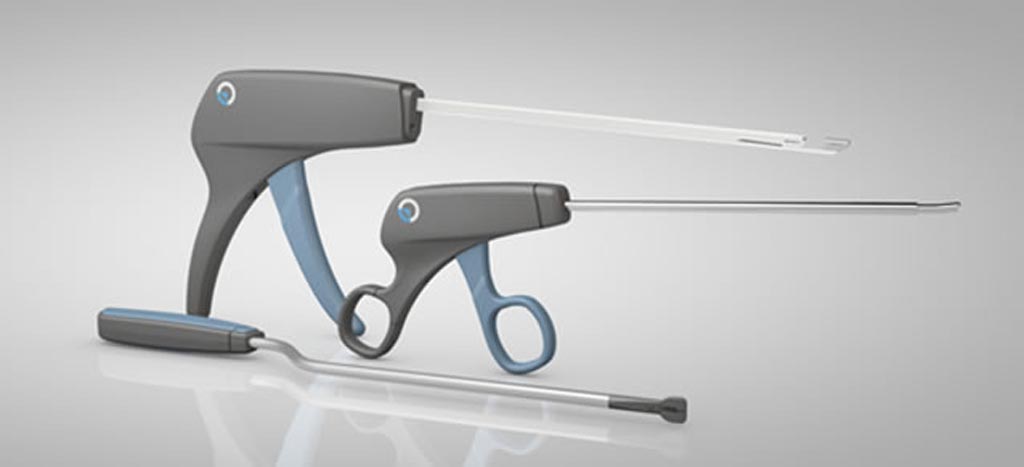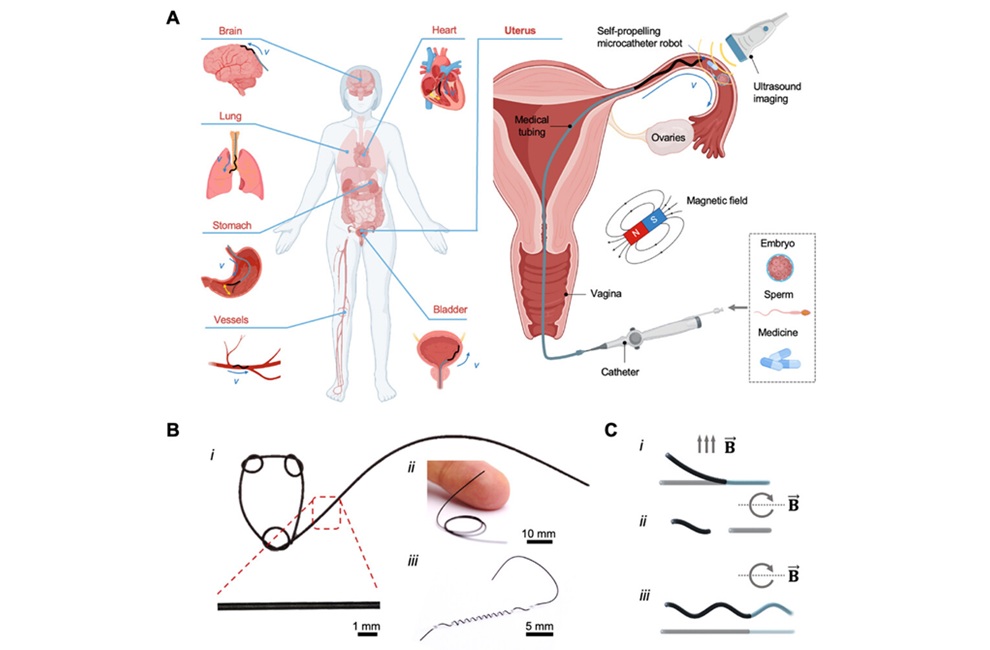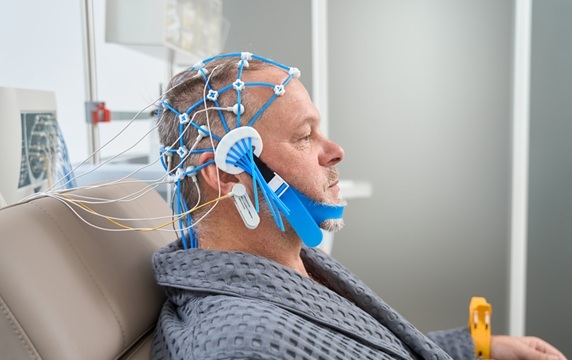Approximation Kit Closes Microdiscectomy Disc Defects
|
By HospiMedica International staff writers Posted on 29 Jul 2019 |

Image: The AnchorKnot Tissue Approximation Kit (Photo courtesy of Anchor Orthopedics).
A novel tissue sparing approximation system minimizes residual defects during herniated disc repair and improves procedural outcomes.
The Anchor Orthopedics XT (Mississauga, Canada) AnchorKnot Tissue Approximation Kit is a set of surgical spinal devices that enable orthopedic surgeons and neurosurgeons to close tissue defects during minimally invasive microdiscectomy of herniated intervertebral discs in the lumbar spine, allowing surgical decompression with minimization of the annular incision and limiting the removal of tissue to include only the free fragments impinging on the nerve root. The kit is comprised of three sterile, single use devices: the Suture Passer, the Knot Pusher, and the Suture Cutter.
The Suture Passer is designed for passing a preloaded non-absorbable ultra-high molecular weight (UHMW) polyethylene surgical suture through soft tissue. The Knot Pusher is a hand-held grip device, with a stainless steel shaft and a slotted tip that is used to push the pre-tied knot down to the tissue level. The Suture Cutter is used to cut the suture once the knot is secured in place. The deployment mechanism of the AnchorKnot tissue approximation kit is designed for simplicity, despite the difficult to reach anatomical location; on average, about five minutes of usage are needed during the procedure.
“Microdiscectomy surgery allows a patient to return to a more healthy state, faster and with less pain; the AnchorKnot kit allows us to repair tissue defects with an elegant device,” said Nilesh Patel, MD, of Michigan Spine Clinic (Brownstown, USA). “This technology represents the next evolution in minimally invasive herniated disc repair. We are always looking to reduce the size of the tissue defect and we see it as a critical step towards our goal of and improving procedure outcomes.”
A lumbar disc herniation is a tear in the outer, fibrous ring (annulus fibrosus) of an intervertebral disc that allows part of, or the entire, soft central portion to be forced out from between two vertebrae, causing back pain, and can also push on nerve roots causing pain, numbness and tingling, as well as weakness in one or both legs. Symptomatic lumbar disc herniation affects 1-2% of the population at some point in their lives, usually between 30-40 years of age, and is one of the most common and debilitating conditions of the spine.
Related Links:
Anchor Orthopedics XT
The Anchor Orthopedics XT (Mississauga, Canada) AnchorKnot Tissue Approximation Kit is a set of surgical spinal devices that enable orthopedic surgeons and neurosurgeons to close tissue defects during minimally invasive microdiscectomy of herniated intervertebral discs in the lumbar spine, allowing surgical decompression with minimization of the annular incision and limiting the removal of tissue to include only the free fragments impinging on the nerve root. The kit is comprised of three sterile, single use devices: the Suture Passer, the Knot Pusher, and the Suture Cutter.
The Suture Passer is designed for passing a preloaded non-absorbable ultra-high molecular weight (UHMW) polyethylene surgical suture through soft tissue. The Knot Pusher is a hand-held grip device, with a stainless steel shaft and a slotted tip that is used to push the pre-tied knot down to the tissue level. The Suture Cutter is used to cut the suture once the knot is secured in place. The deployment mechanism of the AnchorKnot tissue approximation kit is designed for simplicity, despite the difficult to reach anatomical location; on average, about five minutes of usage are needed during the procedure.
“Microdiscectomy surgery allows a patient to return to a more healthy state, faster and with less pain; the AnchorKnot kit allows us to repair tissue defects with an elegant device,” said Nilesh Patel, MD, of Michigan Spine Clinic (Brownstown, USA). “This technology represents the next evolution in minimally invasive herniated disc repair. We are always looking to reduce the size of the tissue defect and we see it as a critical step towards our goal of and improving procedure outcomes.”
A lumbar disc herniation is a tear in the outer, fibrous ring (annulus fibrosus) of an intervertebral disc that allows part of, or the entire, soft central portion to be forced out from between two vertebrae, causing back pain, and can also push on nerve roots causing pain, numbness and tingling, as well as weakness in one or both legs. Symptomatic lumbar disc herniation affects 1-2% of the population at some point in their lives, usually between 30-40 years of age, and is one of the most common and debilitating conditions of the spine.
Related Links:
Anchor Orthopedics XT
Latest Surgical Techniques News
- Catheter-Based Procedures Offer Less Invasive Option for Treatment of Valvular Disease
- Laparoscopic Surgery Improves Outcomes for Severe Newborn Liver Disease
- Novel Endoscopy Technique Provides Access to Deep Lung Tumors
- New Study Findings Could Halve Number of Stent Procedures
- Breakthrough Surgical Device Redefines Hip Arthroscopy
- Automated System Enables Real-Time "Molecular Pathology" During Cancer Surgery
- Groundbreaking Procedure Combines New Treatments for Liver Tumors
- Ablation Reduces Stroke Risk Associated with Atrial Fibrillation
- Optical Tracking Method Identifies Target Areas in Robot-Assisted Neurosurgery
- General Anesthesia Improves Post-Surgery Outcomes for Acute Stroke Patients
- Drug-Coated Balloons Can Replace Stents Even in Larger Coronary Arteries
- Magnetic Kidney Stone Retrieval Device Outperforms Ureteroscopic Laser Lithotripsy
- Absorbable Skull Device Could Replace Traditional Metal Implants Used After Brain Surgery
- Magic Silicone Liquid Powered Robots Perform MIS in Narrow Cavities
- 'Lab-on-a-Scalpel' Provides Real-Time Surgical Insights for POC Diagnostics in OR
- Biodegradable Brain Implant Prevents Glioblastoma Recurrence
Channels
Critical Care
view channel
Bioadhesive Strategy Prevents Fibrosis Around Device Implants on Peripheral Nerves
Peripheral nerves connect the brain and spinal cord to muscles, organs, and sensory systems, making them key targets for treating neurological and systemic diseases. However, implantable bioelectronic... Read more
Miniature Non-Invasive Robotic Catheters to Improve Infertility Treatments
Minimally invasive procedures in reproductive and gynaecological medicine are often limited by the difficulty of navigating narrow, delicate anatomical pathways without damaging surrounding tissue.... Read morePatient Care
view channel
Revolutionary Automatic IV-Line Flushing Device to Enhance Infusion Care
More than 80% of in-hospital patients receive intravenous (IV) therapy. Every dose of IV medicine delivered in a small volume (<250 mL) infusion bag should be followed by subsequent flushing to ensure... Read more
VR Training Tool Combats Contamination of Portable Medical Equipment
Healthcare-associated infections (HAIs) impact one in every 31 patients, cause nearly 100,000 deaths each year, and cost USD 28.4 billion in direct medical expenses. Notably, up to 75% of these infections... Read more
Portable Biosensor Platform to Reduce Hospital-Acquired Infections
Approximately 4 million patients in the European Union acquire healthcare-associated infections (HAIs) or nosocomial infections each year, with around 37,000 deaths directly resulting from these infections,... Read moreFirst-Of-Its-Kind Portable Germicidal Light Technology Disinfects High-Touch Clinical Surfaces in Seconds
Reducing healthcare-acquired infections (HAIs) remains a pressing issue within global healthcare systems. In the United States alone, 1.7 million patients contract HAIs annually, leading to approximately... Read moreHealth IT
view channel
EMR-Based Tool Predicts Graft Failure After Kidney Transplant
Kidney transplantation offers patients with end-stage kidney disease longer survival and better quality of life than dialysis, yet graft failure remains a major challenge. Although a successful transplant... Read more
Printable Molecule-Selective Nanoparticles Enable Mass Production of Wearable Biosensors
The future of medicine is likely to focus on the personalization of healthcare—understanding exactly what an individual requires and delivering the appropriate combination of nutrients, metabolites, and... Read moreBusiness
view channel
Philips and Masimo Partner to Advance Patient Monitoring Measurement Technologies
Royal Philips (Amsterdam, Netherlands) and Masimo (Irvine, California, USA) have renewed their multi-year strategic collaboration, combining Philips’ expertise in patient monitoring with Masimo’s noninvasive... Read more
B. Braun Acquires Digital Microsurgery Company True Digital Surgery
The high-end microsurgery market in neurosurgery, spine, and ENT is undergoing a significant transformation. Traditional analog microscopes are giving way to digital exoscopes, which provide improved visualization,... Read more
CMEF 2025 to Promote Holistic and High-Quality Development of Medical and Health Industry
The 92nd China International Medical Equipment Fair (CMEF 2025) Autumn Exhibition is scheduled to be held from September 26 to 29 at the China Import and Export Fair Complex (Canton Fair Complex) in Guangzhou.... Read more















